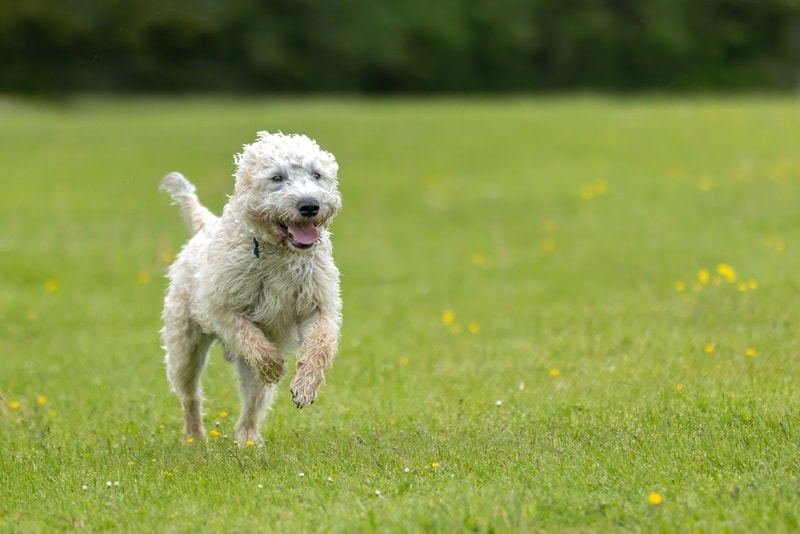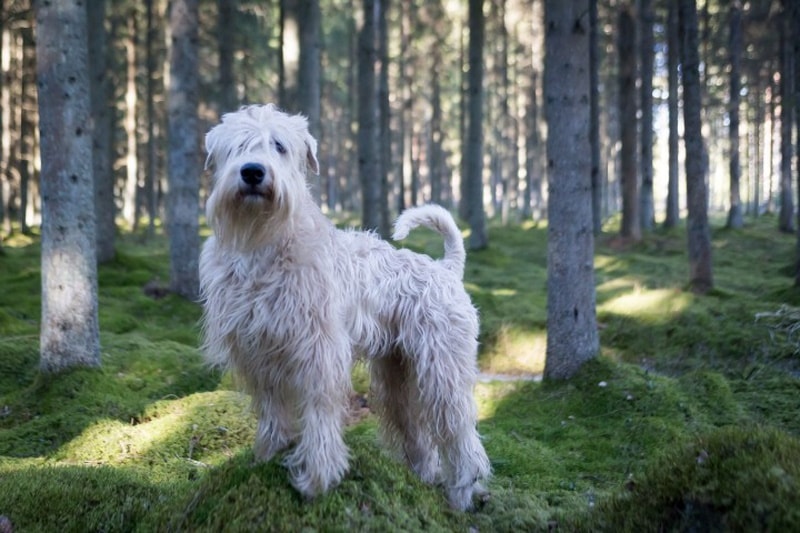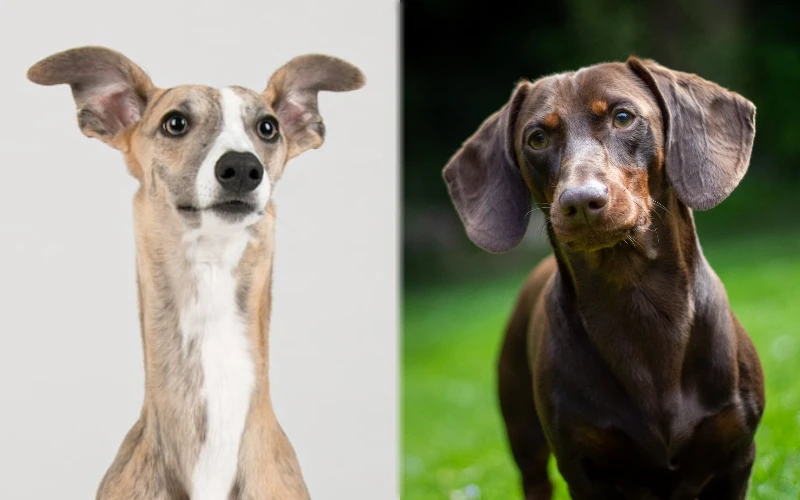White Labradoodle: Pictures, Facts & History
By Lorre Luther
Updated on

| Height: | 14 – 24 |
| Weight: | 25 – 65 pounds |
| Lifespan: | 12 – 15 years |
| Suitable for: | Active families and those looking for playful, affectionate companions |
| Temperament: | Loving, easy-to-train and energetic |
White Labradoodles aren’t a breed but are mixes of Labrador Retrievers and Poodles. Because Labradoodles are mixed-breed dogs, they inherit qualities from both parents, including the coat type and color. There are three Labradoodle coat types: hair, fleece, and wool.
White Labradoodles are Labrador Retriever-Poodle crossbreeds with white fur, and they’re incredibly friendly dogs that make amazing companions. They’re fun, energetic, kind, loving, and great for first-time dog owners and families with kids. They come in various sizes depending on whether their Poodle parent is a Standard, Miniature, or Toy variant.
Labradoodles often make outstanding companions, as they’re smart, energetic, loving, and devoted. They usually have the joyful playfulness of Labrador Retrievers and the intelligence of Poodles, making them easy to train. Most require around 1 hour of daily exercise and often don’t do well when left alone for long periods. They’re well-behaved around children and other animals and are more inclined to make friends with them than to chase other animals.
How Labradoodles Gained Popularity

Labradoodles range in size because they can have Standard, Miniature, or Toy Poodle heritage. The mix was first mentioned in the 1955 book Into the Water Barrier. However, the hybrid dog was not developed for breeding until the 1980s.
In 1989, Wally Cornon and the Royal Guide Dog Association of Australia introduced a Labradoodle breeding program to create “hypoallergenic” guide dogs. Labradors generally make fantastic guide dogs, and Poodles are incredibly smart, love to work, and often trigger fewer reactions in allergy sufferers than other breeds.
In the 1990s, the beginning of the hybrid dog craze, the Labradoodle became popular in the United States. They were imported to Europe in 2006 and eventually became one of the most sought-after hybrids.
However, the temperament and physical characteristics can be difficult to predict in first-generation hybrid dogs, making it challenging to consistently find puppies with specific qualities, including coat type, trainability, and energy levels.
Because dog registries don’t recognize Labradoodles, there’s little breeder oversight, which some suggest has led to the development of dogs with mental and physical health problems.
Are Labradoodles Hypoallergenic?
No. But they can sometimes be good choices for allergy sufferers. Allergies to dogs are generally caused by proteins found in dog saliva, dander, and urine. All dogs make these proteins, so there’s technically no such thing as a hypoallergenic dog.
But there are breeds that typically shed less or produce less of the triggering allergens. Breeds such as Poodles and Portuguese Water Dogs are often considered good choices for those with dog allergies. However, some allergy sufferers end up with itchy eyes and runny noses around “hypoallergenic” breeds. Labradoodles, even from the same litter, produce varying levels of potential allergen triggers.
As mixed-breed dogs, Labradoodles can inherit their Poodle parent’s coat, that of their Labrador parent, or end up with something in between. Labradoodles with long, ropy hair often produce fewer allergens that often trigger problems in humans. Dogs with more Labrador-like coats may still set off allergic reactions in many people.

Are Labradoodles Generally Healthy?
Most of the health issues with Labradoodles relate to the lack of a breed standard. Since there’s no breed standard and little breeder oversight, some suggest that Labradoodles often suffer from mental and physical health problems, such as anxiety and joint problems, due to unethical breeding choices.
Given the variety seen in these dogs, it’s difficult to make generalizations regarding their overall health. Mixed-breed dogs have the potential to develop health conditions found in each of their parents’ breeds, leaving Labradoodles vulnerable to a range of conditions, including hip dysplasia, bloat, and epilepsy.
Poodles are prone to developing Von Willebrand’s Disease, a blood clotting disorder. Labrador Retrievers are at heightened risk for several conditions, including nutritional dilated cardiomyopathy, hemangiosarcoma, hip dysplasia, and elbow joint problems. They also commonly develop ear infections.
Top 4 Unique Facts About Labradoodles
1. Labradoodles Can Have One of Three Coat Types
As mixed-breed dogs, Labradoodles can inherit physical characteristics from both parent breeds. They can have hair, fleece, or wool coats! Hair coats resemble those of Labradors, who often shed. Wool coats hang in dense, long curls similar to that seen in Poodles. Fleece coats are typically soft, curly, and fine. The breed’s grooming requirements vary based on coat type, but most require at least weekly brushing.
2. They Love to Swim
Both Labrador Retrievers and Poodles are accomplished swimmers. Labrador Retrievers were originally bred to work alongside sailors in Northern Canada. Poodles are technically water-retrieving dogs and were often used to retrieve ducks during 18th-century hunts in France. Labradoodles, as mixes of two water-loving breeds, often thrive in water, and many are naturally gifted swimmers. Swimming is fantastic canine exercise as it gets dogs’ hearts pumping while protecting their joints!
3. There Are 2 Types of Labradoodles — F1 and F2 Mixes
F1 Labradoodles are first-generation mixes between a Labrador Retriever and a Poodle. F2 dogs are second-generation Labradoodles with two F1 Labradoodle parents. Some breeders argue that breeding F2 dogs increases the chance of in-breeding genetic diseases and prefer to work breed F1 mixes.

4. They Have Lots of Fans
Jennifer Aniston, Joe Biden, and Tiger Woods have been proud Labradoodle owners at one time or another. The Prince and Princess of Norway had a Labradoodle named Muffins. Other famous Labradoodle owners include Christie Brinkley and Barbara Eden.
Do Labradoodles Make Good Pets?
Labradoodles generally make fantastic pets; they’re loyal, loving, energetic, and friendly. They’re great with children and most other pets, including dogs and cats. Most tend to be quite playful and enthusiastic. With good socialization and solid early obedience training to properly channel their friendly enthusiasm, Labradoodles shine when meeting new people or interacting with other animals. They’re often wonderful companions for children since they’re patient and loving.
They require a good amount of physical activity, and most need around 1 hour per day of exercise, including walks and unstructured playtime. They’re usually incredibly easy to train, making Labradoodles excellent choices for first-time dog owners.
Grooming requirements vary based on coat type, but most require at least weekly brushing and anywhere from two to six annual professional grooming appointments. Their teeth should be brushed at least three times per week, and most benefit from regular monthly nail clipping.
Conclusion
White Labradoodles have qualities from both parent breeds but are often more flexible and adaptable because of their mixed heritage. They can be found in several colors, including black, cream, red, and white! These popular hybrid dogs are typically sweet, energetic, intelligent, and devoted. Most are gentle and appropriately playful around children and other animals. Because they’re so good-natured and easy to train, they’re often fantastic choices for first-time dog owners.
Featured Image Credit: Steve Gill Photography, Shutterstock













